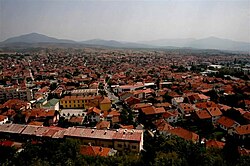Radoviš
| Радовиш Radoviš |
|||
|---|---|---|---|
| City | |||

Centre of Radoviš
|
|||
|
|||
| Location in the Republic of Macedonia | |||
| Coordinates: 41°38′10″N 22°28′0″E / 41.63611°N 22.46667°ECoordinates: 41°38′10″N 22°28′0″E / 41.63611°N 22.46667°E | |||
| Country |
|
||
| Municipality |
|
||
| Government | |||
| • Mayor | Sashko Nikolov (VMRO-DPMNE) | ||
| Area | |||
| • Total | 374.5 km2 (144.6 sq mi) | ||
| Elevation | 380 m (1,250 ft) | ||
| Population (2002) | |||
| • Total | 16,223 | ||
| • Density | 43.32/km2 (26.92/sq mi) | ||
| Time zone | CET (UTC+1) | ||
| • Summer (DST) | CEST (UTC+2) | ||
| Post codes | 2420, 2421 | ||
| Area code(s) | 032 (+389 32) | ||
| Patron saint | Saint Spaso of Radoviš | ||
| Car plates | RA | ||
| Climate | Cfa | ||
| Website | radovis.gov.mk | ||
Radoviš (Macedonian: Радовиш [ˈradɔviʃ]) is a city in the southeastern part of the Republic of Macedonia. It is the second largest city in the southeastern region. The city is the seat of Radoviš Municipality, which is spread on the bottom of Plačkovica Mountain and the northern part of the Radoviš-Strumica valley. The main road M6 Štip–Radoviš-Strumica is tangentially placed on the township of Radoviš. This road is a main communication route with other parts of the country.
The town of Radoviš was mentioned for the first time in 1019 during the reign of the Byzantine King Basil II (which was the name of the town during the Middle Ages. At this time in history, Radoviš is an important center for regional trade, craftsmanship and mining. At that time, the town was located in the North-West of the town's present location, on the banks of the Old river, where we can find traces of several churches, for example St. Archangel church.
In the 14th century, after the withdrawal of the Byzantine Empire, Radoviš found itself in the Serb medieval state. In 1361, the tsar Uroš sojourned in Radoviš. During the Ottoman Empire, in the 17th Century under the Kyustendil sanjak, it belonged to the diocese of the Kustendil metropolitan. At that time, the town had 3,000–4,000 inhabitants.
The Medieval period of Radoviš is characterized by the expansion and development of Radoviš and its surroundings. The economical, political and educational histories of the region can attest to this. In the territory of the Municipality of Radoviš are located both explored and unexplored archeological sites, monasteries, and churches all of which are truly a part of a rich heritage of culture monuments. In addition, this territory dates back to prehistoric times and contain artifacts from the Neolithic, Eneolithic, Halsta and the Bronze Ages. In the time of Philip the Second and Alexander the Great, poems about the territory of the Municipality of Radoviš were written. Also, numerous remains date back to Roman times and even earlier. Additional findings include ancient settlements, terms and aqueducts.
...
Wikipedia



